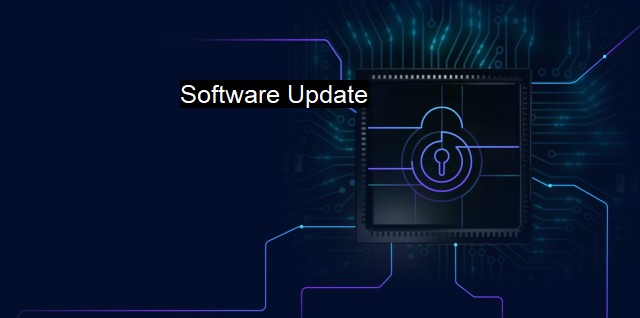What is Software Update?
The Importance of Software Updates for Cybersecurity and Antivirus Solutions
"Software update" colloquially refers to the upgradation and advancement of software systems for the purpose of performance improvements or to fix the shortcomings or vulnerabilities of their previous versions. Besides performance or enhancements, software update underscore the subject of cybersecurity. They play a vital part in locating and eliminating the vulnerabilities in software, hosting antivirus functionalities, and making systems more robust against cyber threats.Cybersecurity is the practice of defending computers, mobile devices, servers, electronic systems, networks, and data from digital intrusions. It comprises multiple layers of defense delivered in the realms of tech and users, and network infrastructure with numerous security measures in place. A significant aspect of cybersecurity in safeguarding systems and data against cyber threats is the regular updating of software and firmware (embedded software).
Developers consistently manage system vulnerabilities through continuous versions of the software that refortify the security parameters capable of protecting against any incoming threats. A failure in this upkeep allows hackers or malicious software to exploit these software bugs and weaknesses for the intention of illegal activities, ranging from ransomware attacks to personal data theft.
While several cyber threats fall under the malware category, very few threats exist in the form of viruses. Viruses, characterized by their capability to clone themselves and spread across different systems, pose an enormous cybersecurity challenge. Antivirus software surfaces as a mechanism to tackle these threats. This subclass of cybersecurity uniquely focuses on identifying, blocking, and, when possible, eliminating virus threats from the system. Antivirus software scans files or your computer's memory for specific patterns that may match its checklist of virus "signatures."
The software updates here unequivocally become indispensable, similar to the way they are for other software types. Antivirus software utilizes virus definitions to flag potential threats. Developers keep releasing newer definitions to keep up with the ever-evolving and innovative threats surfacing in cyberspace. let’s consider malware that wasn't considered a threat at the time the antivirus software was designed. If the antivirus software isn't updated to recognize this malware variant, it can't mark it as a threat. Hence, without regular updates, antivirus software is almost futile.
Naturally, delays in deadlines, setbacks from development hang-ups, or any obstruction impacting the software's fogging process can render software susceptive to cyber threats during this window period. Ok Patch Management process addresses such threats by prioritizing the software updates as per their security impact, thereby enhancing the cybersecurity framework.
Beyond improving a user's digital experience, software updates carry paramount importance as a routine cybersecurity exercise in contemporary tech-saturated lives. They are particularly significant in honing antivirus mechanisms to render them equal to evolving malware threats continually.
Despite, every wave of software updates growing significantly in size and their frequency increasing, staying up to date with these software changes assures a user that just as cyber-attackers adapt and expand their areas of operation, so has their digital defense system braced up against them. A consciously updated software is, therefore, the first layer of defense in the cybersecurity dimension.
To sum up, software updates embody an absolutely essential element of cybersecurity and antivirus defense as they necessarily patch existing vulnerabilities and augment capabilities for threat aversion. In this realm where threats constantly evolve, perpetual vigilance and incessant updating develop into a reliable bulwark, validating the contemporary dictum in cybersecurity: your security is as steadfast as your last software update.

Software Update FAQs
What is a software update in the context of cybersecurity?
A software update refers to a release of code that introduces improvements, fixes bugs or enhances the security features of a program, application or operating system. In cybersecurity, software updates are critical as they address known vulnerabilities that can be exploited by attackers to gain unauthorized access to computer systems, steal data, or carry out other malicious activities.Why is it important to regularly update antivirus software?
Regularly updating antivirus software is crucial as new malware and viruses are constantly being developed by cybercriminals. Antivirus software updates incorporate the latest virus definitions and detection technologies to protect against these evolving threats. Without timely updates, antivirus software may fail to detect and remove new malware, leaving your systems and data vulnerable to attacks.What are the risks of not updating software in cybersecurity?
Not updating software in cybersecurity can expose your systems to a range of risks, including malware infections, data breaches, and ransomware attacks. Outdated software often contains known vulnerabilities that attackers can exploit to gain access to your systems and data. Moreover, failing to update software can result in non-compliance with regulatory requirements, exposing your organization to legal and financial penalties.How can I ensure that my software is up-to-date and secure?
To ensure that your software is up-to-date and secure, you should regularly check for updates and patches from the software vendor or manufacturer. If available, enable automatic software updates, which will ensure that the latest security features and patches are installed as soon as they become available. You should also regularly review the cybersecurity posture of your systems and networks, and implement additional security measures where necessary to protect against emerging threats.| | A | | | B | | | C | | | D | | | E | | | F | | | G | | | H | | | I | | | J | | | K | | | L | | | M | |
| | N | | | O | | | P | | | Q | | | R | | | S | | | T | | | U | | | V | | | W | | | X | | | Y | | | Z | |
| | 1 | | | 2 | | | 3 | | | 4 | | | 7 | | | 8 | | |||||||